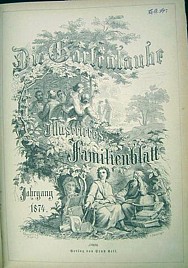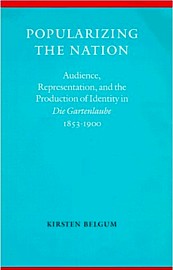Essay (back
to top)
Cultivating the Seeds of German National Identity
The nationalism of the 19th century in Germany came about as a result
of many different factors, including the press and more specifically,
the circulation of magazines. The book Popularizing the Nation: Audience,
Representation, and the Production of Identity in ‘Die Gartenlaube’,
by Kirsten Belgum, carefully examines the effects that the family magazine
Die Gartenlaube had on the development of German nationalism.
Belgum begins by exploring the factors that enabled the magazine to reach
a significant portion of the German population. These factors included
increased literacy and distribution, reduced censorship, and advancing
technology. The increased literacy, which was at 90 percent by the late
nineteenth century, was a product of the increased number of children
attending school. Distribution increased as a result of the increased
population in cities, meaning more people had access to libraries and
bookstores, and improved transportation, which enabled the magazine to
be shipped faster to a larger area. After the 1848 revolutions most censorship
laws were lifted, but only for a short time, which prompted the creation
of a greater number of magazines, including the Gartenlaube.
Aside from a brief period in Prussia, the Gartenlaube was never
banned, enabling it to grow steadily in its readership. The rapid advancement
in technology during the nineteenth century resulted in the creation of
more efficient printing techniques, which meant that a larger number of
copies could be printed in a smaller amount of time.
Die Gartenlaube was the brainchild of Ernst Keil, a liberal bent on unification of the German nation. Keil was imprisoned during the 1848 revolution for liberal material that he published during that time. The magazine was therefore a result of his desire to spread his nationalist liberal ideas. He used the magazine as a tool to accomplish his goal of educating “his fellow Germans to active and responsible citizenship” (Belgum xv).
The period after the 1848 revolution in Germany was one of uncertainty in regards to the future of the German state. The revolution was unsuccessful in creating a democratic state and the foremost question in the minds of the German leaders was, how they were going to form a German nation and who would be included in this new nation. The eventual answer to the German question came in the form of the creation of a national German identity, or what it meant to be German, united by a powerful leader, Bismarck. The ability of the creators of Die Gartenlaube to appeal to a large audience, include all peoples of German heritage (even those in other countries), and cover victories and accomplishments of notable Germans eventually made the magazine a considerable force pushing Germany towards a national identity and subsequent political unification.
The Gartenlaube was “the only periodical in nineteenth-century Germany to reach a circulation near 400,000, at a time when most daily newspapers did not print more than 4,000 copies” ( qtd. in Belgum 16). The secret to its success was its ability to appeal to a large portion of the German population by including topics from the latest German inventions to detailed descriptions of notable German monuments. The liberal slant of the magazine made it popular among the middle classes but it also made a conscious effort to win the readership of the lower classes by way of writing about subjects that pertained to them, such as emigration. One of the most important audiences of the periodical was women, so many articles focused on women’s place in society, and domestic life was featured as well, the magazine’s dedication to informing people about a variety of topics and inclusion of several audiences in its articles helped in its goal of unifying the German people in order to create a sense of German national unity.
The topics covered in Die Gartenlaube varied  greatly but they all helped to fuel the feeling of nationalism that Keil had made his goal. Although there were numerous subjects discussed in the magazine, there were several that became prominent and were central to communicating a sense of national unity. These topics included German inventions, national monuments, wars, and international exhibitions, among others. greatly but they all helped to fuel the feeling of nationalism that Keil had made his goal. Although there were numerous subjects discussed in the magazine, there were several that became prominent and were central to communicating a sense of national unity. These topics included German inventions, national monuments, wars, and international exhibitions, among others.
The nineteenth century was a time of significant technological advances in the industrialized nations of the world. Leading these advances and discoveries were the countries of England, France, and America. Germany, in the first half of the nineteenth century, lagged behind these nations in its industrialization and technological advances because of its uncentralized leadership and other factors. During the 1860s the editors of the Gartenlaube made a conscious effort to support German ingenuity. This can be seen in the periodical’s numerous articles on the German inventor Wilhelm Bauer. As a result of these articles detailing his latest works Bauer became somewhat of a hero in Germany for his achievements. As Belgum states, “the inventor became a resource of the nation and the success or failure of the nation was tied to its participation in the modernization process” (Belgum 66). In concentrating on the accomplishments of one inventor, the periodical gave the German people a national celebrity that worked for the advancement of the nation. The acclaim Bauer received in the articles helped to prompt national pride in German ingenuity, and as a result aided in the Gartenlaube’s goal of creating a sense of nationalism within Germany and her people.
National monuments were also a frequent topic in Die Gartenlaube. The detailed articles about these monuments allowed average Germans (who probably had never seen or even heard of them) to learn about and take pride in their construction and meaning. Belgum states that the “essays about these colossal structures enabled the representation of the nation within a single image” (Belgum 86). This beckons to the days of the Roman Empire when great statues and arches (like Constantine’s) were erected to not only glorify the emperor but consequently evoked a sense of imperial pride. In addition to the articles, there were also pictures to go along with the verbal description of the monument. Belgum points out that, “in the combination of text and illustration, past and present were conjoined in the portrayal of the nation” (Belgum 96). The end result of these numerous articles about the great national monuments of Germany was an increased awareness of the abilities and accomplishments of notable Germans and an elevated sense of national pride within common German citizens.
The most obvious topic utilized by Die Gartenlaube to evoke feelings of national pride were the numerous articles about the various wars in which Germany was involved. So much so that “events of war often occupied up to two-thirds of the space in a weekly issue of publications” (Belgum 76). Although these articles concerning war were of great political importance to the nation, they often contained more discussion of the technology used in the war rather than the war itself. This resulted in the idea that “the outcome of war came to mean the progress of the nation in technological terms” (Belgum 77). Even though many of the articles regarding wars did not stick to the details of the actual war, they still accomplished the Gartenlaube’s goal of creating a sense of national identity.
The ability of the editors of the magazine to include all German peoples in the articles enabled them to create a sense of what it meant to be German. The magazine and its articles were obviously mostly directed towards Germans living in Germany, but they also managed to include Germans living in other countries. For example, there were several articles published in Die Gartenlaube throughout its circulation that focused on the different locations in which there were German emigrants living, usually the more exotic locations such as Brazil. In doing this they not were not only unifying the German nation, but the German people as a distinct unit.
The efforts of the editors of Die Gartenlaube to include women in their push for a national identity resulted in many articles that catered to the female situation and feminine fancy. Belgum points out that “the explicit inclusion of women readers was central to the Gartenlaube’s establishment of the middle-class family as the basic building block of German national identity” (Belgum 121). The articles that were directed towards the female audience were usually the weekly series of parts of popular novels. Many of these stories involved a middle class heroine who fulfilled her position of domesticity while remaining strong in the face of opposition. The stories furthered the sense of national identity by giving women a feeling of power and significance while reaffirming their place in the national scheme. The most impressive part of the Gartenlaube’s courtship of female readers is the fact that one of their most popular writers of these stories was woman by the name of E. Marlitt whose literary contributions to the magazine helped to reaffirm the new power given to women. In tapping this resource of female support for the cause of national identity the editors of the Gartenlaube in turn were able to educate and motivate this significant population to do their part in making it a reality.
Conclusion (back to top)
Die Gartenlaube and other periodicals of the time played a crucial role in the expansion of the idea of a united German population, but there were also other vehicles that drove this new nationalism. These included national clubs such as singing groups, fraternities, and gymnasiums. Some historians argue that these clubs were irreplaceable in their aid of German nationalism, as Martin Kitchen states in A History of Modern Germany: “These associations played a vital political role, and as national organizations contributed significantly to the creation of a national identity” (Kitchen 49). Although these clubs and groups did play a role in the development of national identity, their significance was overshadowed by the role of the press. This is because the press was far more accessible to the general population of Germany, whereas clubs “did not grow beyond a few thousand members and consisted primarily of adult men” (Belgum xvii). As proved by the success of DieGartenlaube and other periodicals, and the resulting national identity that these publications evoked, there was no other element that could claim the role of “vital” to the national cause.
The course of German nationalism and the creation of a distinct national identity was, as illustrated in the above reasoning, in many ways a product of the press and, specifically, DieGartenlaube. “The magazine simultaneously viewed itself both as a product that had to appeal to a public and as the creator of that public” (Belgum 139). In doing this, the editors of DieGartenlaube were using the articles presented in the magazine to help them mold the national identities and views of the German people. |
 Die Gartenlaube, 1874
Die Gartenlaube, 1874

 greatly but they all helped to fuel the feeling of nationalism that Keil had made his goal. Although there were numerous subjects discussed in the magazine, there were several that became prominent and were central to communicating a sense of national unity. These topics included German inventions, national monuments, wars, and international exhibitions, among others.
greatly but they all helped to fuel the feeling of nationalism that Keil had made his goal. Although there were numerous subjects discussed in the magazine, there were several that became prominent and were central to communicating a sense of national unity. These topics included German inventions, national monuments, wars, and international exhibitions, among others.